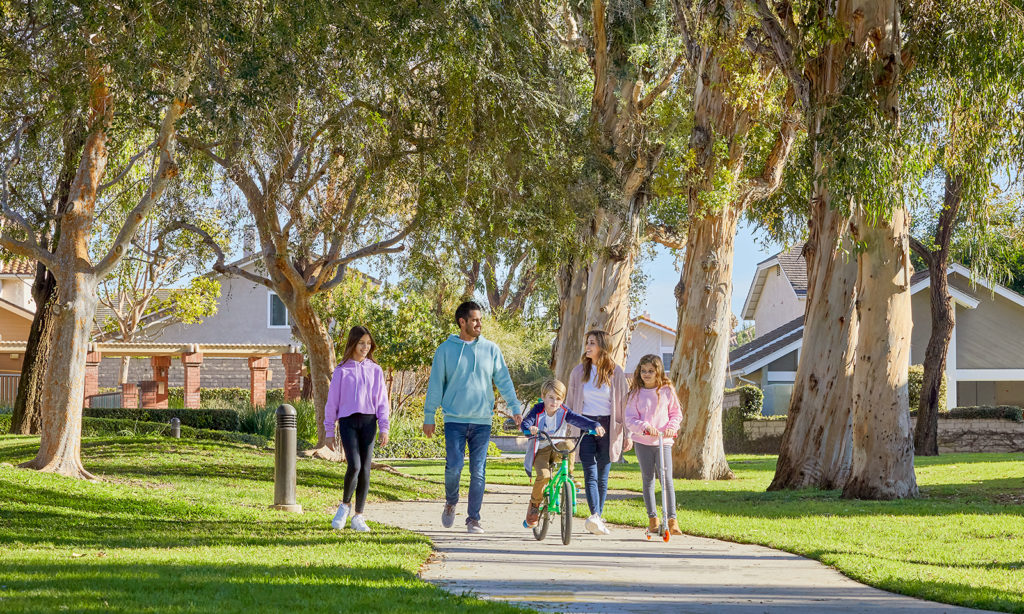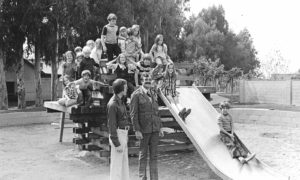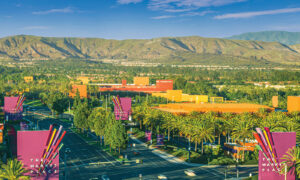Ask Irvine residents where they live, and you’ll often hear: “Turtle Rock” or “Oak Creek” or “Portola Springs.”
That’s a testament to the Master Plan’s vision to create a city of villages.
Each of Irvine’s 24 self-contained communities – from University Park, built in 1966, to the latest, Orchard Hills – is valued for a simple reason. The smart design and distinct sense of place makes life easier and more sociable.
“The villages make Irvine feel like a small town within a city of 310,000 people,” says Stephen Kimbrell, the lead pastor at Grace City Church.
Six years ago, Kimbrell and his wife and three children moved to Northwood Village from New Bern, North Carolina, (pop. 29,895). “After just a few months, we were blown away by how many people we knew who we’d see at the grocery store,” he says. “Even coming from the South, I didn’t see that kind of community back home.”
That neighborly feel is a leading reason why a recent survey found nearly 90% of Irvine residents rate their quality of life as “excellent” or “good,” versus just 1% who are unsatisfied. The independent researcher that conducted the survey noted the positive numbers were “unprecedented” in the firm’s decades of work in cities throughout the country.
The village design also has led to consistently strong property values. Irvine homes appreciate faster during good times and depreciate slower during more challenging periods than many comparable cities. Since 2010, Irvine’s new-home values have increased over 40% more than the average new home in Orange County, according to the market intelligence firm Zonda.

‘This is precious land’
From the start, Irvine Company officials appreciated their historic opportunity to create a brand-new city from scratch.
“This is precious land,” former Irvine Company President Raymond L. Watson once said. Watson and his colleagues determined they would pursue a master-planned vision, rather than subdivide land to other companies, and went to great lengths to figure out their approach.
“Even coming from the South, I didn’t see that kind of community back home.” – Stephen Kimbrell, resident
Along the way, they consulted with sociologists and focus groups to gain insights into how people most wanted to live. Watson soon learned how important it is for people to feel part of a society. He began referring to his team as “master community builders.”
Roots in Europe’s ‘garden cities’
The early 1960s, when Irvine was still on the drawing board, was a thrilling time for urban developers all over the world. U.S. planners, in the midst of a budding environmental movement, were seeking creative alternatives to suburban sprawl and smog. Europeans, still rebuilding from the war, were developing “New Towns” – rigorously planned small communities meant to ease congestion in major metropolises.
Both efforts were influenced by the “garden city movement” that had emerged in the United Kingdom in the early 1900s. Several European New Towns incorporated key elements of those early communities, including concentrically designed neighborhoods set off by greenbelts, abundant local parks and nearby opportunities to play and shop.
In 1965, Watson joined William Pereira, the architect overseeing the Irvine Master Plan, along with chief planner Al Treviño Jr. on a two-week journey through New Towns in six European countries. Of note, future Irvine Company Chairman Donald Bren also participated in the tour.
Having studied the garden city movement at Harvard, Treviño says he already intended to incorporate several of their features. But he also envisioned departing from the model by including a variety of housing, such as affordable rental townhouses and apartments. Irvine’s new communities could thereby benefit from having more diverse types of residents – including essential workers such as police officers, teachers, and nurses – than was standard in U.S. suburbs.
It was around this time, according to Watson, that the team landed on a word for the new small communities they envisioned. “We started calling them villages,” Watson said.
Unique to Irvine: Schools at the heart of villages
Watson determined that Irvine’s small villages would differ from the European versions in another key manner. Whereas the New Towns were built around a central park and city offices, he proposed that Irvine’s villages be built around schools, which he understood as fulcrums of U.S. family life.
As Irvine students went on to set high performance standards, the new school district’s success attracted more high-achieving families, creating a virtuous cycle for anyone with an Irvine address.
Irvine becomes the ‘ultimate model’
More than half a century after Irvine planners flew to Europe to see what they could learn, community planners now journey to Irvine to learn of its unmatched success, notes urban expert Joel Kotkin, the author of several books, including “The Human City: Urbanism for the Rest of Us.”
“Planners around the world today look at Irvine and see it as the ultimate role model,” Kotkin says.
The reasons go beyond the hardy economic value of Irvine homes. Many Irvine residents say they treasure the local cohesiveness that has helped make Irvine the safest city of its size for the past 16 years, according to FBI data.
More than half a century after Irvine planners flew to Europe to see what they could learn, community planners now journey to Irvine to learn of its unmatched success.
People meet up on local hiking trails and at pools and playgrounds. Besides that, an abundance of green space and the ability to walk or bike to schools, shops and jobs – with some of the shortest commutes in the country – give residents an edge in staying healthy and fit.
“This is the lifestyle that 80% of Americans desire,” says Kotkin, who cites several new communities, including developments outside Houston, Dallas and Columbus, Ohio, that have tried to take pages from Irvine’s book. “It’s exceedingly clear that these kinds of developments are hugely popular with people,” he adds, “but I haven’t yet seen any of them that are as evolved as Irvine.”
Through the Decades
Master planning Irvine’s 24 Villages









